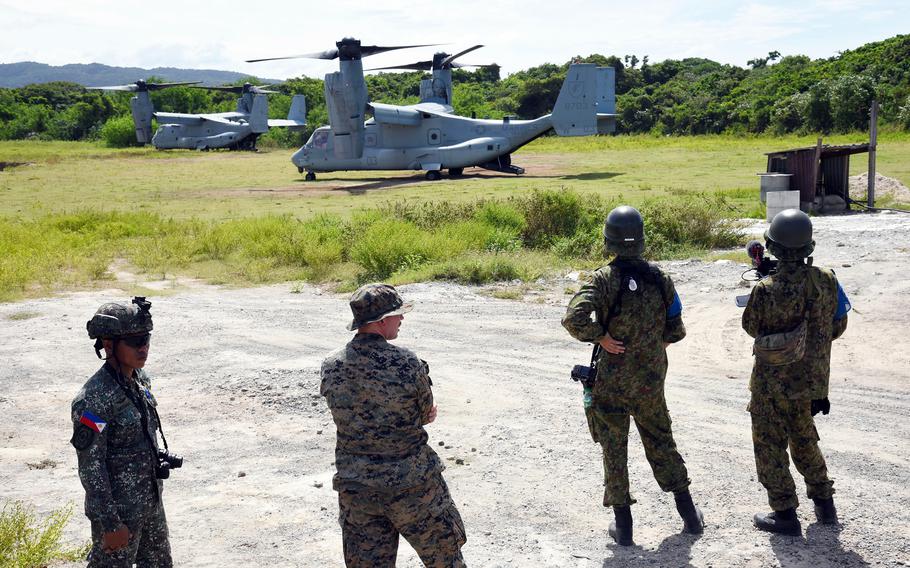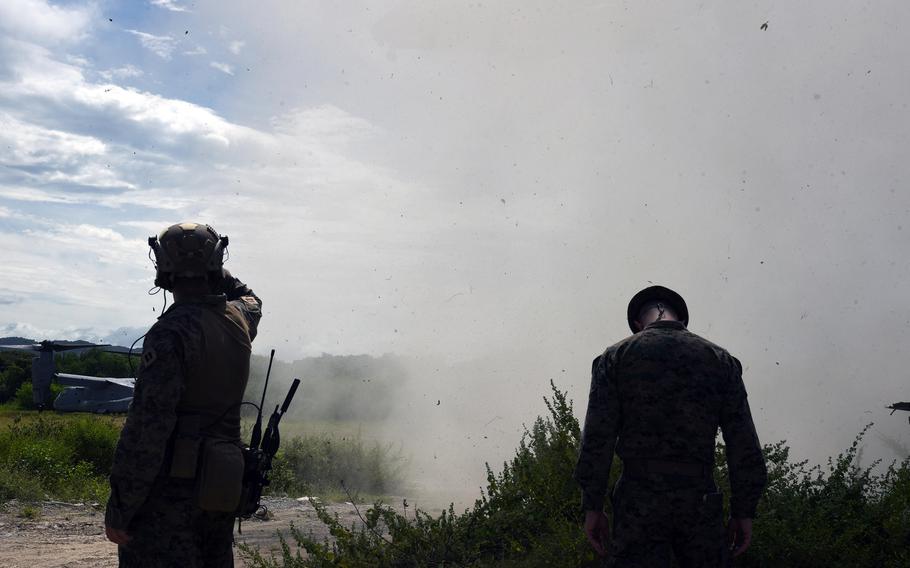
Troops from the Philippines, U.S. and Japan watch a Marine Corps MV-22B Osprey land during disaster-response training near Camp Cape Bojeador, Philippines, Oct. 20, 2024. (Seth Robson/Stars and Stripes)
Philippine facilities made available to U.S. forces under a decade-old defense pact may serve as disaster-relief command centers, according to a Philippine military spokeswoman.
The 2014 Enhanced Defense Cooperation Agreement allows the United States to build facilities and position supplies and equipment at nine sites across the Philippines.
The sites were activated for relief and rescue operations ahead of Tropical Storm Trami last week, the state-run Philippine News Agency reported Oct. 23.
The death toll from the storm, which struck the islands Oct. 22, and an approaching typhoon, reached 111 with nearly 2 million households affected, the agency reported Tuesday.
EDCA sites have been used to prepare and send supplies to disaster areas, Philippine military spokeswoman Col. Francel Margareth Padilla said during a televised briefing Monday, reported that day by Philippine broadcaster ABS-CBN News.

Members of Marine Rotational Force-Southeast Asia shelter from dust kicked up by an MV-22B Osprey during disaster-response training near Camp Cape Bojeador, Philippines, Oct. 20, 2024. (Seth Robson/Stars and Stripes)
“Over and above that, EDCA sites may also serve as a command-and-control point for multiple nations,” she said.
The chief of the Philippine military, Army Gen. Romeo Brawner, told reporters Oct. 23 at Camp Aguinaldo in Quezon city that his American counterparts were ready to deploy planes to the sites ahead of the storm.
However, U.S. forces’ capabilities were not required for the mission, Capt. Mark McDonough, a spokesman for Marine Rotational Force-Southeast Asia, told Stars and Stripes on Friday by text message from the Philippines.
Members of the rotational force and the 15th Marine Expeditionary Unit, embarked on the amphibious assault ship USS Boxer, helped deliver supplies to Filipinos struck by Super Typhoon Krathon on Sept. 30.
The Marines used forklifts that were prepositioned in Manila during that operation, 15th MEU commander Col. Sean Dynan told Stars and Stripes on Oct. 22 on Palawan.
Around 200 15th MEU members were on Palawan training with Philippine marines last week but flew off the island ahead of the storm, Dynan said.
“We are pulling straight back to ship because that’s going to impact seas and weather for air,” he said. “Otherwise, we get stuck here for four to five days.”
The Philippines is preparing for Typhoon Kong-rey, which packs sustained winds of over 80 mph and gusts up to almost 100 mph. The storm is expected to strike the country’s north Thursday.